Quantifying the Impact of Fertilizer-Induced Reactive Nitrogen Emissions on Surface Ozone Formation in China: Insights from FEST-C* and CMAQ Simulations
Abstract
1. Introduction
2. Data and Methodology
2.1. Model Description and Configurations
2.2. Data Sources
2.3. Ground-Based Observation
2.4. Data Analysis
3. Results and Discussion
3.1. Cropland Nr Emissions in China
3.2. Evaluation of CMAQ Model Performance
3.3. Impact of Cropland Nr Emissions on Regional Ozone Formation
3.4. Comparison with Previous Studies
3.5. Limitations and Uncertainties
4. Conclusions
Author Contributions
Funding
Institutional Review Board Statement
Data Availability Statement
Conflicts of Interest
References
- Ainsworth, E.A.; Yendrek, C.R.; Sitch, S. The effects of tropospheric ozone on net primary productivity and implications for climate change. Annu. Rev. Plant Biol. 2012, 63, 637–661. [Google Scholar] [CrossRef]
- Lefohn, A.S.; Malley, C.S.; Smith, L. Tropospheric ozone assessment report: Global ozone metrics for climate change, human health, and crop/ecosystem research. Elem. Sci. Anth. 2018, 6, 27. [Google Scholar] [CrossRef]
- Lu, X.; Zhang, L.; Wang, X. Rapid increases in warm-season surface ozone and resulting health impact in China since 2013. Environ. Sci. Technol. Lett. 2020, 7, 240–247. [Google Scholar] [CrossRef]
- Prather, M.; Zhu, X. Lifetimes and timescales of tropospheric ozone: Global metrics for climate change, human health, and crop/ecosystem research. Elem. Sci. Anthr. 2024, 12, 00112. [Google Scholar] [CrossRef]
- Atkinson, R. Atmospheric chemistry of VOCs and NOx. Atmos. Environ. 2000, 34, 2063–2101. [Google Scholar] [CrossRef]
- Rajabi, H.; Mosleh, M.H.; Mandal, P. Emissions of volatile organic compounds from crude oil processing–Global emission inventory and environmental release. Sci. Total Environ. 2020, 727, 138654. [Google Scholar] [CrossRef]
- Panchasara, H.; Samrat, N.H.; Islam, N. Greenhouse gas emissions trends and mitigation measures in Australian agriculture sector—A review. Agriculture 2021, 11, 85. [Google Scholar] [CrossRef]
- Zhang, Q.; Liu, P.; Wang, Y. Unveiling the underestimated direct emissions of nitrous acid (HONO). Proc. Nat. Acad. Sci. USA 2023, 120, e2302048120. [Google Scholar] [CrossRef]
- Cech, R.; Leisch, F.; Zaller, J.G. Pesticide use and associated greenhouse gas emissions in sugar beet, apples, and viticulture in Austria from 2000 to 2019. Agriculture 2022, 12, 879. [Google Scholar] [CrossRef]
- Koppmann, R.; Von Czapiewski, K.; Reid, S. A review of biomass burning emissions, part I: Gaseous emissions of carbon monoxide, methane, volatile organic compounds, and nitrogen containing compounds. Atmos. Chem. Phys. 2005, 5, 10455–10516. [Google Scholar]
- Oswald, R.; Behrendt, T.; Ermel, M. HONO emissions from soil bacteria as a major source of atmospheric reactive nitrogen. Science 2013, 341, 1233–1235. [Google Scholar] [CrossRef] [PubMed]
- Nie, W.; Ding, A.; Xie, Y.N. Influence of biomass burning plumes on HONO chemistry in eastern China. Atmos. Chem. Phys. 2015, 15, 1147–1159. [Google Scholar] [CrossRef]
- Theys, N.; Volkamer, R.; Müller, F. Global nitrous acid emissions and levels of regional oxidants enhanced by wildfires. Nat. Geosci. 2020, 13, 681–686. [Google Scholar] [CrossRef]
- Wolfe, A.H.; Patz, J.A. Reactive nitrogen and human health: Acute and long-term implications. Ambio 2002, 31, 120–125. [Google Scholar] [CrossRef]
- Tan, W.; Wang, H.; Su, J. Soil emissions of reactive nitrogen accelerate summertime surface ozone increases in the North China Plain. Environ. Sci. Technol. 2023, 57, 12782–12793. [Google Scholar] [CrossRef]
- Emmerling, C.; Krein, A.; Junk, J. Meta-analysis of strategies to reduce NH3 emissions from slurries in European agriculture and consequences for greenhouse gas emissions. Agronomy 2020, 10, 1633. [Google Scholar] [CrossRef]
- Wang, C.; Amon, B.; Schulz, K. Factors that influence nitrous oxide emissions from agricultural soils as well as their representation in simulation models: A review. Agronomy 2021, 11, 770. [Google Scholar] [CrossRef]
- Schindlbacher, A.; Zechmeister-Boltenstern, S.; Butterbach-Bahl, K. Effects of soil moisture and temperature on NO, NO2, and N2O emissions from European forest soils. J. Geophys. Res.-Atmos. 2004, 109, D17. [Google Scholar] [CrossRef]
- Chang, W.L.; Brown, S.S.; Stutz, J.; Middlebrook, A.M.; Bahreini, R.; Wagner, N.L. Evaluating N2O5 heterogeneous hydrolysis parameterizations for CalNex 2010. J. Geophys. Res.-Atmos. 2016, 121, 5051–5070. [Google Scholar] [CrossRef]
- Li, Y.; Wang, X.; Wu, Z. Atmospheric nitrous acid (HONO) in an alternate process of haze pollution and ozone pollution in urban Beijing in summertime: Variations, sources and contribution to atmospheric photochemistry. Atmos. Res. 2021, 260, 105689. [Google Scholar] [CrossRef]
- Wang, Y.; Wang, Y.; Li, Q. Soil Emissions of Reactive Oxidized Nitrogen Reduce the Effectiveness of Anthropogenic Source Control in China. Environ. Sci. Technol. 2024, 58, 21015–21024. [Google Scholar] [CrossRef]
- Bhattarai, H.R.; Wanek, W.; Siljanen, H.M.P. Denitrification is the major nitrous acid production pathway in boreal agricultural soils. Commun. Earth Environ. 2021, 2, 54. [Google Scholar] [CrossRef]
- Liu, S.; Lin, F.; Wu, S. A meta-analysis of fertilizer-induced soil NO and combined NO+ N2O emissions. Glob. Change Biol. 2017, 23, 2520–2532. [Google Scholar] [CrossRef]
- Wang, Y. Improved modelling of soil NOx emissions in a high temperature agricultural region: Role of background emissions on NO2 trend over the US. Environ. Res. Lett. 2021, 16, 084061. [Google Scholar] [CrossRef]
- Almaraz, M.; Bai, E.; Wang, C. Agriculture is a major source of NOx pollution in California. Sci. Adv. 2018, 4, eaao3477. [Google Scholar] [CrossRef]
- Sha, T.; Ma, X.; Zhang, H. Impacts of Soil NO x Emission on O3 Air Quality in Rural California. Environ. Sci. Technol. 2021, 55, 7113–7122. [Google Scholar] [CrossRef]
- Lu, X.; Ye, X.; Zhou, M. The underappreciated role of agricultural soil nitrogen oxide emissions in ozone pollution regulation in North China. Nat. Commun. 2021, 12, 5021. [Google Scholar] [CrossRef]
- Wang, Y.; Fu, X.; Wang, T. Large contribution of nitrous acid to soil-emitted reactive oxidized nitrogen and its effect on air quality. Environ. Sci. Technol. 2023, 57, 3516–3526. [Google Scholar] [CrossRef]
- Cui, X.; Guo, L.; Li, C. The total biomass nitrogen reservoir and its potential of replacing chemical fertilizers in China. Renew. Sustain. Energy Rev. 2021, 135, 110215. [Google Scholar] [CrossRef]
- Liu, X.; Tai, A.P.K.; Fung, K.M. Responses of surface ozone to future agricultural ammonia emissions and subsequent nitrogen deposition through terrestrial ecosystem changes. Atmos. Chem. Phys. 2021, 21, 17743–17758. [Google Scholar] [CrossRef]
- Huang, L.; Fang, J.; Liao, J. Insights into soil NO emissions and the contribution to surface ozone formation in China. Atmos. Chem. Phys. 2023, 23, 14919–14932. [Google Scholar] [CrossRef]
- Xue, C.; Ye, C.; Lu, K. Reducing Soil-Emitted Nitrous Acid as a Feasible Strategy for Tackling Ozone Pollution. Environ. Sci. Technol. 2024, 58, 9227–9235. [Google Scholar] [CrossRef]
- Shen, Y.; Xiao, Z.; Wang, Y. Impacts of agricultural soil NOx emissions on O3 over mainland China. J. Geophys. Res.-Atmos. 2023, 128, e2022D037986. [Google Scholar] [CrossRef]
- Wang, R.; Bei, N.; Wu, J. Cropland nitrogen dioxide emissions and effects on the ozone pollution in the North China plain. Environ. Pollut. 2022, 294, 118617. [Google Scholar] [CrossRef]
- Fan, M.Y.; Hong, Y.; Zhang, Y.L. Increasing nonfossil fuel contributions to atmospheric nitrate in urban China from observation to prediction. Environ. Sci. Technol. 2023, 57, 18172–18182. [Google Scholar] [CrossRef]
- Sha, T.; Yang, S.; Chen, Q. Large contributions of soil emissions to the atmospheric nitrogen budget and their impacts on air quality and temperature rise in North China. Atmos. Chem. Phys. 2024, 24, 8441–8455. [Google Scholar] [CrossRef]
- Rasool, Q.Z.; Zhang, R.; Lash, B. Enhanced representation of soil NO emissions in the Community Multiscale Air Quality (CMAQ) model version 5.0. 2. Geosci. Model. Dev. 2016, 9, 3177–3197. [Google Scholar] [CrossRef]
- Souri, A.H.; Choi, Y.; Jeon, W. Constraining NOx emissions using satellite NO2 measurements during 2013 DISCOVER-AQ Texas campaign. Atmos. Environ. 2016, 131, 371–381. [Google Scholar] [CrossRef]
- Rasool, Q.Z.; Bash, J.O.; Cohan, D.S. Mechanistic representation of soil nitrogen emissions in the Community Multiscale Air Quality (CMAQ) model v 5.1. Geosci. Model. Dev. 2019, 12, 849–878. [Google Scholar] [CrossRef]
- Luo, L.; Ran, L.; Rasool, Q.Z.; Cohan, D.S. Integrated modeling of US agricultural soil emissions of reactive nitrogen and associated impacts on air pollution, health, and climate. Environ. Sci. Technol. 2022, 56, 9265–9276. [Google Scholar] [CrossRef]
- Yienger, J.; Levy, H. Empirical model of global soil-biogenic NOx emissions. J. Geophys. Res.-Atmos. 1995, 100, 11447–11464. [Google Scholar] [CrossRef]
- Hudman, R.C.; Moore, N.E.; Mebust, A.K.; Martin, R.V.; Russell, A.R.; Valin, L.C.; Cohen, R.C. Steps towards a mechanistic model of global soil nitric oxide emissions: Implementation and space based-constraints. Atmos. Chem. Phys. 2012, 12, 7779–7795. [Google Scholar] [CrossRef]
- Ran, L.; Yuan, Y.; Cooter, E.; Benson, V.; Yang, D.; Pleim, J.; Wang, R.; Williams, J. An integrated agriculture, atmosphere, and hydrology modeling system for ecosystem assessments. Adv. Model. Earth Syst. 2019, 11, 4645–4668. [Google Scholar] [CrossRef]
- Iacono, M.; Delamere, S.; Mlawer, E. Radiative forcing by long-lived greenhouse gases: Calculations with the AER radiative transfer models. J. Geophys. Res.-Atmos. 2008, 113, D13. [Google Scholar] [CrossRef]
- Morrison, H.; Gettelman, A. A new two-moment bulk stratiform cloud microphysics scheme in the Community Atmosphere Model, version 3 (CAM3). Part I: Description and numerical tests. J. Clim. 2008, 21, 3642–3659. [Google Scholar] [CrossRef]
- Pleim, J.E. A combined local and nonlocal closure model for the atmospheric boundary layer. Part II: Application and evaluation in a mesoscale meteorological model. J. Appl. Meteorol. Clim. 2007, 46, 1396–1409. [Google Scholar] [CrossRef]
- Kain, J.S. The Kain–Fritsch convective parameterization: An update. J. Appl. Meteorol. 2004, 43, 170–181. [Google Scholar] [CrossRef]
- Pleim, J.E.; Xiu, A. Development and testing of a surface flux and planetary boundary layer model for application in mesoscale models. J. Appl. Meteorol. 1995, 34, 16–32. [Google Scholar] [CrossRef]
- Xu, K.M.; Randall, D.A. A semiempirical cloudiness parameterization for use in climate models. J. Atmos. Sci. 1996, 53, 3084–3102. [Google Scholar] [CrossRef]
- Jiang, Y.; Wang, S.; Xing, J.; Zhao, B.; Li, S.; Chang, X.; Zhang, S.; Dong, Z. Ambient fine particulate matter and ozone pollution in China: Synergy in anthropogenic emissions and atmospheric processes. Environ. Res. Lett. 2022, 17, 123001. [Google Scholar] [CrossRef]
- Xu, W.; Luo, X.; Pan, Y.; Zhang, L.; Tang, A.; Shen, J.; Liu, X. Quantifying atmospheric nitrogen deposition through a nationwide monitoring network across China. Atmos. Chem. Phys. 2015, 15, 12345–12360. [Google Scholar] [CrossRef]
- Zheng, B.; Cheng, J.; Geng, G. Mapping anthropogenic emissions in China at 1 km spatial resolution and its application in air quality modeling. Sci. Bull. 2021, 66, 612–620. [Google Scholar] [CrossRef]
- Crippa, M.; Guizzardi, D.; Muntean, M. Gridded emissions of air pollutants for the period 1970–2012 within EDGAR v4. 3.2. Earth Syst. Sci. Data 2018, 10, 1987–2013. [Google Scholar] [CrossRef]
- Yang, J.; Huang, X. 30 m annual land cover and its dynamics in China from 1990 to 2019. Earth Syst. Sci. Data 2021, 13, 3907–3925. [Google Scholar] [CrossRef]
- Ran, L.; Cooter, E.; Yang, D.; Benson, V.; Yuan, Y.P.; Hanna, A.; Garcia, V. User’s Guide for the Fertilizer Emission Scenario Tool for CMAQ (FEST-C) Version 1.4. Community Modeling and Analysis System. Available online: https://www.cmascenter.org/fest-c/ (accessed on 10 November 2024).
- Nachtergaele, F.; van Velthuizen, H.; Verelst, L.; Wiberg, D.; Henry, M.; Chiozza, F. Harmonized World Soil Database Version 2.0M. 2023. Available online: https://www.fao.org/soils-portal/data-hub/soil-maps-and-databases/harmonized-world-soil-database-v20/en/ (accessed on 23 November 2024).
- Wang, K.; Gao, C.; Wu, K. ISAT v2. 0: An integrated tool for nested-domain configurations and model-ready emission inventories for WRF-AQM. Geosci. Model. Dev. 2023, 16, 1961–1973. [Google Scholar] [CrossRef]
- Gan, C.; Li, B.; Dong, J. Atmospheric HONO emissions in China: Unraveling the spatiotemporal patterns and their key influencing factors. Environ. Pollut. 2024, 343, 123228. [Google Scholar] [CrossRef]
- Wu, D.M.; Xia, Y.L.; Hou, L.; Liu, M. The mechanisms of HONO emissions from soil: A review. Chin. J. Eco-Agric. 2018, 26, 190–194. [Google Scholar]
- Ermel, M.; Behrendt, T.; Oswald, R. Hydroxylamine released by nitrifying microorganisms is a precursor for HONO emission from drying soils. Sci. Rep. 2018, 8, 1877. [Google Scholar] [CrossRef]
- Song, Y.; Wu, D.; Ju, X. Nitrite stimulates HONO and NOx but not N2O emissions in Chinese agricultural soils during nitrification. Sci. Total Environ. 2023, 902, 166451. [Google Scholar] [CrossRef]
- Zhang, M.D.; Zhang, X.L.; Gao, C.; Zhao, H.M.; Zhang, S.C.; Xie, S.J.; Ran, L.M.; Xiu, A.J. Reactive nitrogen emissions from cropland and their dominant driving factors in China. Sci. Total Environ. 2025, 968, 178919. [Google Scholar] [CrossRef]
- Xue, C.; Ye, C.; Zhang, C. Evidence for strong HONO emission from fertilized agricultural fields and its remarkable impact on regional O3 pollution in the summer North China Plain. ACS Earth Space Chem. 2021, 5, 340–347. [Google Scholar] [CrossRef]
- Chen, W.; Guenther, A.B.; Jia, S. Synergistic effects of biogenic volatile organic compounds and soil nitric oxide emissions on summertime ozone formation in China. Sci. Total Environ. 2022, 828, 154218. [Google Scholar] [CrossRef]
- Song, X.; Li, X.B.; Yuan, B. Elucidating key factors in regulating budgets of ozone and its precursors in atmospheric boundary layer. NPJ Clim. Atmos. Sci. 2024, 7, 262. [Google Scholar] [CrossRef]
- Niu, Y.; Huang, X.; Wang, H.; Wang, S.; Lin, X.; Chen, Y. Effects of nighttime heterogeneous reactions on the formation of secondary aerosols and ozone in the Pearl River Delta. Sci. Bull. 2022, 67, 2060–2068. [Google Scholar] [CrossRef]
- Wu, D.; Zhang, J.; Wang, M.; An, J.; Wang, R.; Haider, H.; Ri, X.; Huang, Y.; Zhang, Q.; Zhou, F.; et al. Global and regional patterns of soil nitrous acid emissions and their acceleration of rural photochemical reactions. Geophys. Res. Atmos. 2022, 127, e2021D036379. [Google Scholar] [CrossRef]
- Wang, M.; Kroeze, C.; Strokal, M.; Ma, L. Reactive nitrogen losses from China’s food system for the shared socioeconomic pathways (SSPs). Sci. Total Environ. 2017, 605, 884–893. [Google Scholar] [CrossRef]
- Gu, B.; Ju, X.; Chang, J.; Ge, Y.; Vitousek, P.M. Integrated reactive nitrogen budgets and future trends in China. Proc. Natl. Acad. Sci. USA 2015, 112, 8792–8797. [Google Scholar] [CrossRef]
- Wu, H.; Wang, S.; Gao, L.; Zhang, L.; Yuan, Z.; Fan, T.; Huang, L. Nutrient-derived environmental impacts in Chinese agriculture during 1978–2015. Environ. Manag. 2018, 217, 762–774. [Google Scholar] [CrossRef]
- Cui, S.; Shi, Y.; Groffman, P.M.; Schlesinger, W.H.; Zhu, Y.G. Centennial-scale analysis of the creation and fate of reactive nitrogen in China (1910–2010). Proc. Natl. Acad. Sci. USA 2013, 110, 2052–2057. [Google Scholar] [CrossRef]
- Huang, Y.; Li, D. Soil nitric oxide emissions from terrestrial ecosystems in China: A synthesis of modeling and measurements. Sci. Rep. 2014, 4, 7406. [Google Scholar] [CrossRef]
- Lin, J.; Khanna, N.; Liu, X.; Teng, F.; Wang, X. China’s non-CO2 greenhouse gas emissions: Future trajectories and mitigation options and potential. Sci. Rep. 2019, 9, 16095. [Google Scholar] [CrossRef]
- Xu, P.; Chen, A.; Houlton, B.Z.; Zeng, Z.; Wei, S.; Zhao, C.; Zheng, Y. Spatial variation of reactive nitrogen emissions from China’s croplands codetermined by regional urbanization and its feedback to global climate change. Geophys. Res. Lett. 2020, 47, e2019GL086551. [Google Scholar] [CrossRef]
- Shen, Y.; Xiao, Z.; Wang, Y. Multisource remote sensing based estimation of soil NOx emissions from fertilized cropland at high-resolution: Spatio-temporal patterns and impacts. J. Geophys. Res.-Atmos. 2022, 127, e2022JD036741. [Google Scholar] [CrossRef]
- Ma, R.; Yu, K.; Xiao, S.; Liu, S.; Ciais, P.; Zou, J. Data-driven estimates of fertilizer-induced soil NH3, NO and N2O emissions from croplands in China and their climate change impacts. Glob. Change Biol. 2022, 28, 1008–1022. [Google Scholar] [CrossRef]
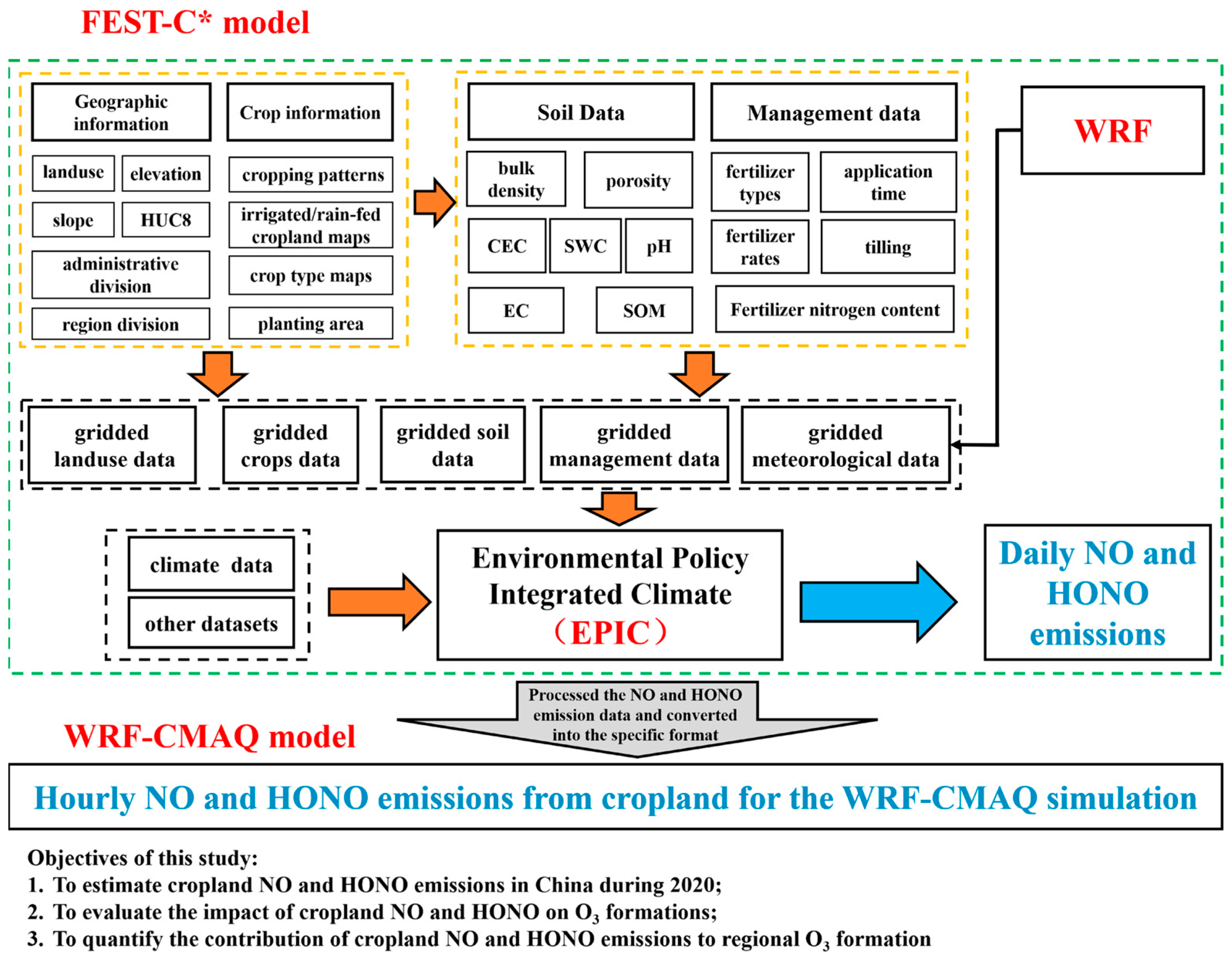
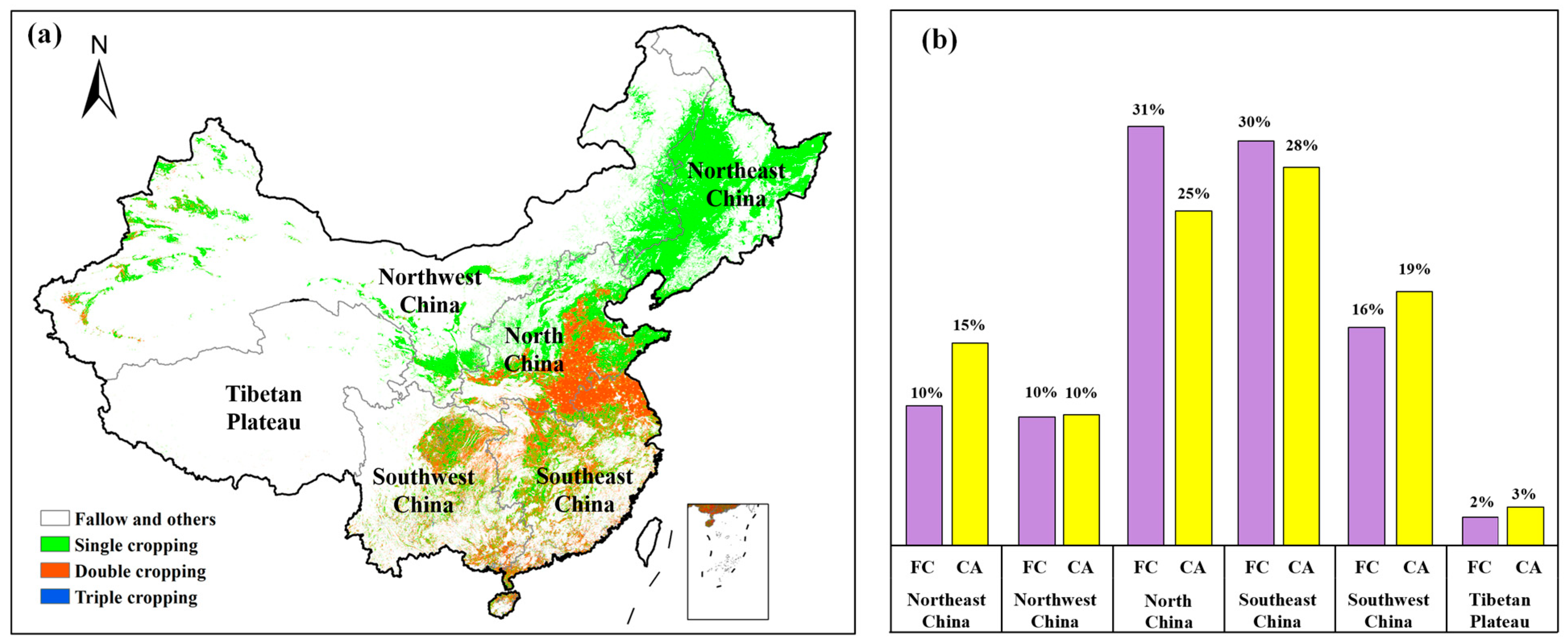


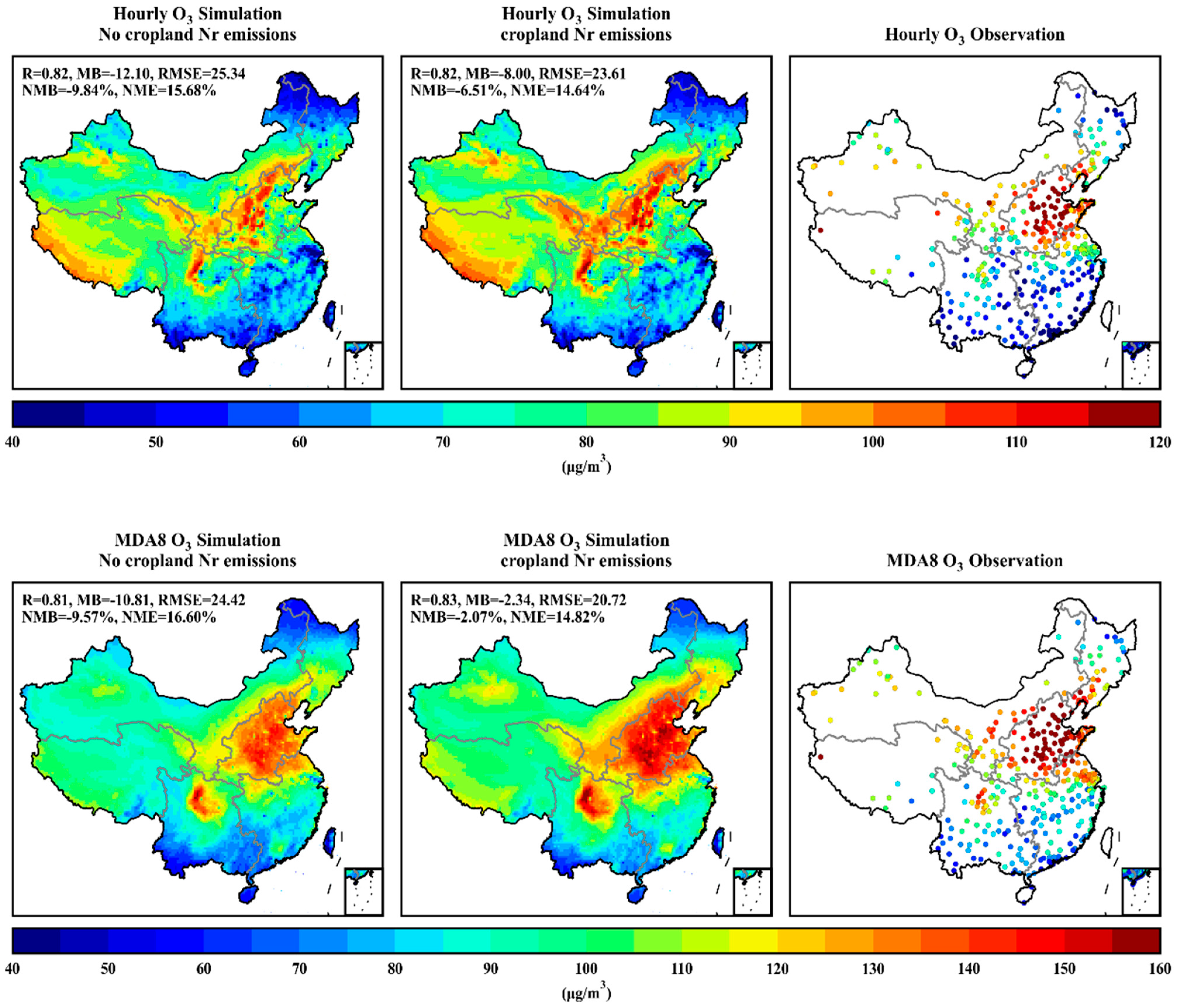
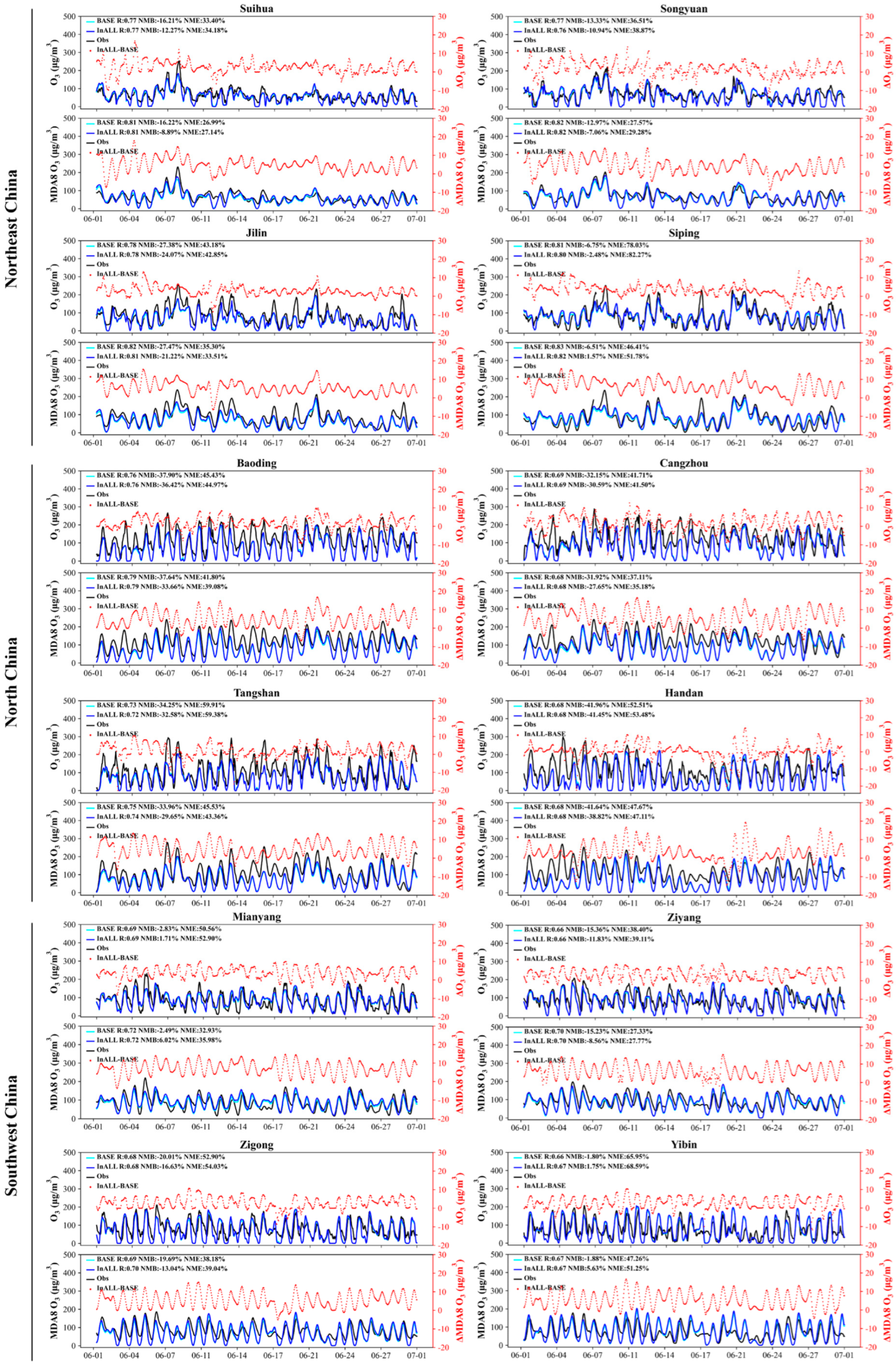
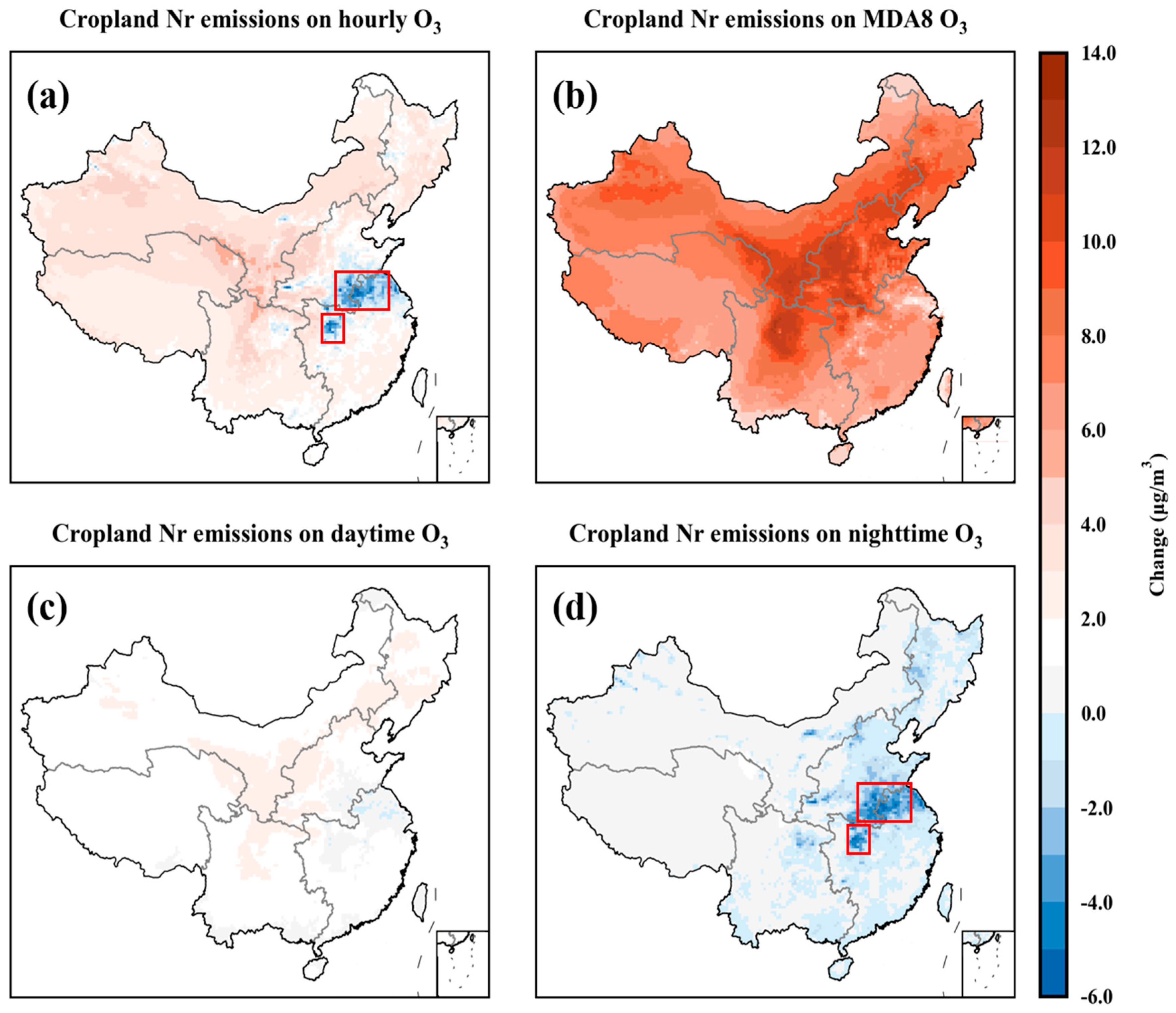
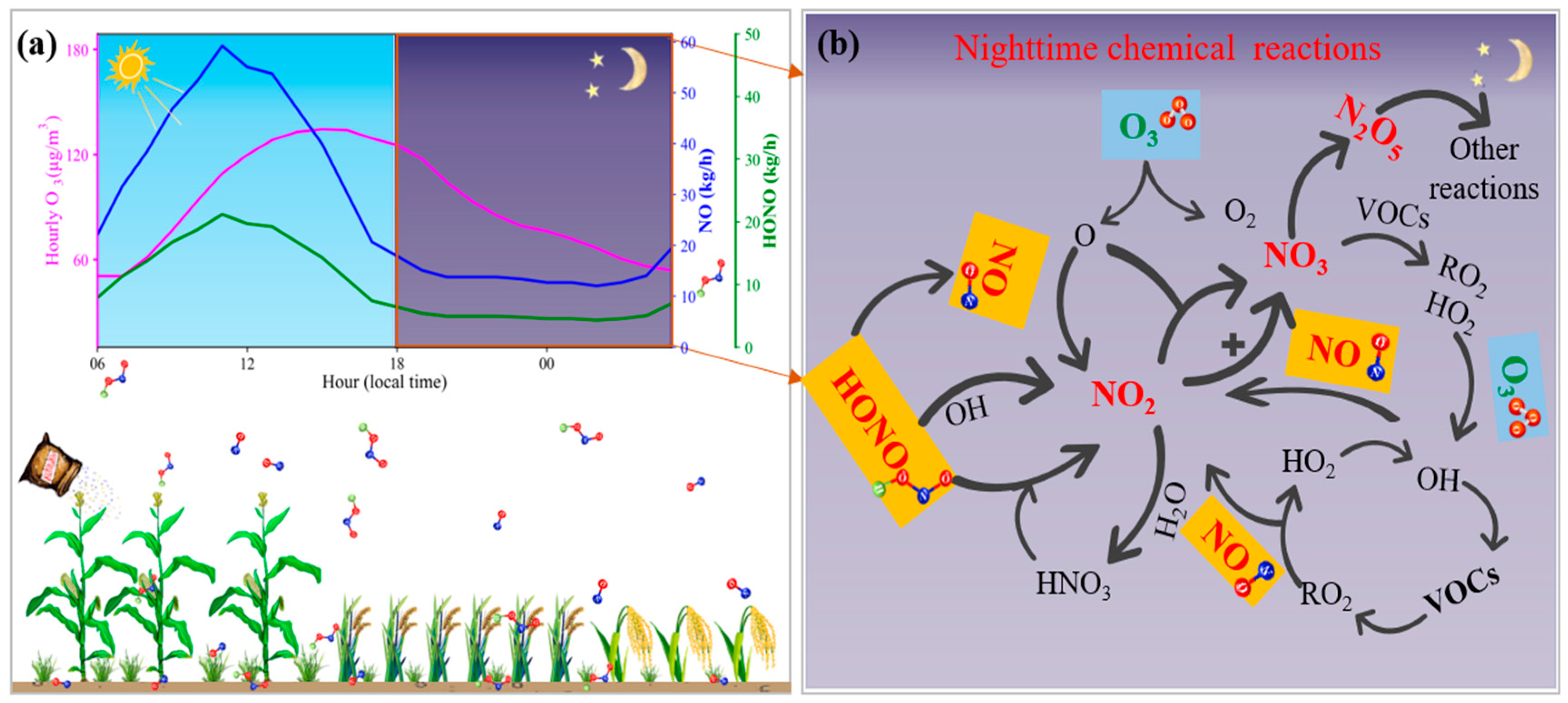
| Categories | Description | Schemes and Data |
|---|---|---|
| Domain | Grid numbers | 190 (x) × 170 (y) |
| Horizontal resolution | 27 km | |
| Vertical layers | 30 levels | |
| Physics parameterization | Shortwave radiation | RRTMG [44] |
| Longwave radiation | RRTMG [44] | |
| Cloud microphysics | Morrison [45] | |
| Planetary boundary layer | ACM2 [46] | |
| Cumulus | Kain–Fritsch [47] | |
| Surface | Pleim–Xiu [48] | |
| Land surface | Pleim–Xiu LSM [48] | |
| ICloud | Xu–Randall [49] | |
| Chemistry scheme | Aerosol mechanism | AERO6 |
| Gas-phase chemistry | CB6 | |
| Emissions | Anthropogenic emission | MEIC (2020) [52], EDGAR (2018) [53] |
| Dust emission | Foroutan | |
| Sea-salt emission | Gong | |
| Input data | Meteorological ICs and BCs | FNL |
| Chemical ICs and BCs | WACCM |
| Region | NO | HONO | Nr |
|---|---|---|---|
| Northeast China (NE) | 0.06 | 0.07 | 0.13 |
| Northwest China (NW) | 0.06 | 0.03 | 0.09 |
| North China (NC) | 0.24 | 0.30 | 0.54 |
| Southeast China (SE) | 0.19 | 0.10 | 0.29 |
| Southwest China (SW) | 0.09 | 0.07 | 0.16 |
| Tibetan Plateau (TP) | 0.02 | 0.03 | 0.05 |
| Total China | 0.66 | 0.60 | 1.26 |
| Region | Hourly O3 | MDA8 O3 | ||||||
|---|---|---|---|---|---|---|---|---|
| BASE | InNr | InNr-BASE | (InNr-BASE)/BASE | BASE | InNr | InNr-BASE | (InNr-BASE)/BASE | |
| NE | 65.66 | 68.05 | 2.39 | 3.65 | 91.00 | 97.71 | 6.71 | 7.37 |
| NW | 78.39 | 81.74 | 3.34 | 4.27 | 94.31 | 102.36 | 8.05 | 8.54 |
| NC | 89.03 | 90.78 | 1.76 | 1.97 | 127.41 | 139.12 | 11.71 | 9.19 |
| SE | 65.64 | 66.83 | 1.19 | 1.81 | 92.31 | 99.45 | 7.14 | 7.73 |
| SW | 70.62 | 73.21 | 2.59 | 3.66 | 86.90 | 93.71 | 6.81 | 7.84 |
| TP | 86.95 | 89.98 | 3.03 | 3.49 | 95.40 | 102.20 | 6.80 | 7.13 |
| Total China | 77.00 | 79.63 | 2.63 | 3.42 | 97.89 | 105.76 | 7.87 | 7.97 |
| Species | Sources | Methods | Regions | Simulation Periods | Contributions to MDA8 O3 Enhancement | References |
|---|---|---|---|---|---|---|
| NO | Soil | BDSNP + CAMx | China | June 2018 | 5.7% | [31] |
| YL95 + WRF-Chem | NW, NC, NE, SW | July 2017 | 32.5%, 38.3%, 41.9%, 31.2% | [33] | ||
| Cropland | BDSNP + GEOS-Chem | NCP | July 2017 | 3.7% | [27] | |
| BDSNP + WRF-Chem | NCP, BTH | 24 May−7 June 2020 | 5.4%, 4.2% | [34] | ||
| Nr (NO + HONO) | Soil | BDISNP + GEOS-Chem | China, NCP | June−July 2019 | 9.7%, 10.1% | [15] |
| BDISNP + WRF-Chem | BTH, FWP | July 2018 | 16.9%, 17.2% | [36] | ||
| Cropland | FEST-C* + CMAQ | China, NC | June 2020 | 8.0%, 9.2% | This study |
Disclaimer/Publisher’s Note: The statements, opinions and data contained in all publications are solely those of the individual author(s) and contributor(s) and not of MDPI and/or the editor(s). MDPI and/or the editor(s) disclaim responsibility for any injury to people or property resulting from any ideas, methods, instructions or products referred to in the content. |
© 2025 by the authors. Licensee MDPI, Basel, Switzerland. This article is an open access article distributed under the terms and conditions of the Creative Commons Attribution (CC BY) license (https://creativecommons.org/licenses/by/4.0/).
Share and Cite
Zhang, M.; Zhang, X.; Gao, C.; Zhao, H.; Zhang, S.; Xie, S.; Xiu, A. Quantifying the Impact of Fertilizer-Induced Reactive Nitrogen Emissions on Surface Ozone Formation in China: Insights from FEST-C* and CMAQ Simulations. Agriculture 2025, 15, 612. https://doi.org/10.3390/agriculture15060612
Zhang M, Zhang X, Gao C, Zhao H, Zhang S, Xie S, Xiu A. Quantifying the Impact of Fertilizer-Induced Reactive Nitrogen Emissions on Surface Ozone Formation in China: Insights from FEST-C* and CMAQ Simulations. Agriculture. 2025; 15(6):612. https://doi.org/10.3390/agriculture15060612
Chicago/Turabian StyleZhang, Mengduo, Xuelei Zhang, Chao Gao, Hongmei Zhao, Shichun Zhang, Shengjin Xie, and Aijun Xiu. 2025. "Quantifying the Impact of Fertilizer-Induced Reactive Nitrogen Emissions on Surface Ozone Formation in China: Insights from FEST-C* and CMAQ Simulations" Agriculture 15, no. 6: 612. https://doi.org/10.3390/agriculture15060612
APA StyleZhang, M., Zhang, X., Gao, C., Zhao, H., Zhang, S., Xie, S., & Xiu, A. (2025). Quantifying the Impact of Fertilizer-Induced Reactive Nitrogen Emissions on Surface Ozone Formation in China: Insights from FEST-C* and CMAQ Simulations. Agriculture, 15(6), 612. https://doi.org/10.3390/agriculture15060612






